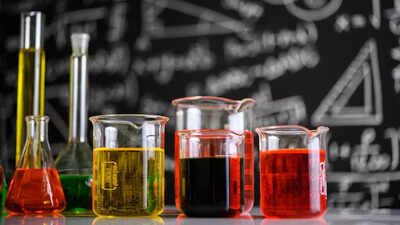- News
- Education News
- Learning with TOI News
- How does pH affect chemical reactions in the body?
Trending
This story is from June 10, 2023
How does pH affect chemical reactions in the body?
pH is a measure of a solution's acidity or alkalinity. Acids have a pH below 7, releasing hydrogen ions when dissolved in water, while bases have a pH above 7, releasing hydroxide ions. Enzymes have specific pH ranges where they work most efficiently, and extreme pH levels can impair protein structure and function. Cells require specific pH levels for normal functions, and the body regulates pH through buffer systems to maintain acid-base homeostasis. Maintaining a proper pH balance is essential for optimal health and bodily functions.

pH is a measure of how acidic or basic a solution is. It plays a crucial role in regulating chemical reactions that occur in the body. The pH scale ranges from 0 to 14, with 7 considered neutral, values below 7 acidic, and values above 7 basic. Let's explore how pH affects chemical reactions in the body in simple terms.
Acids are substances that release hydrogen ions (H+) when dissolved in water.They have a pH value less than 7. The higher the concentration of hydrogen ions, the more acidic the solution. For example, stomach acid is highly acidic, with a pH of around 1-2, aiding in the digestion of food.
pH and Bases
Bases, also known as alkaline substances, are the opposite of acids. They release hydroxide ions (OH-) when dissolved in water. Bases have a pH value greater than 7. The higher the concentration of hydroxide ions, the more basic the solution. For example, baking soda (sodium bicarbonate) is a common household base used in baking. It has a pH of around 9.
Enzymes are proteins that catalyze chemical reactions in the body. They play a vital role in various biological processes. Enzymes have specific pH ranges at which they work most efficiently. For example, digestive enzymes in the small intestine function optimally at a slightly basic pH of around 7.5-8.5.
Proteins, which are essential for many bodily functions, have a specific structure that can be influenced by pH. Extreme pH levels can disrupt protein structure, leading to denaturation (loss of function). For example, changes in pH can affect the structure of enzymes, rendering them inactive and impairing their ability to facilitate chemical reactions.
Maintaining the appropriate pH is crucial for cells to function properly. Cells have specific pH requirements for processes such as nutrient uptake, waste removal, and energy production. For example: Blood has a tightly regulated pH of around 7.35-7.45. Any significant deviations from this range can disrupt cellular processes and lead to health issues.
The body has mechanisms to maintain a stable pH balance, known as acid-base homeostasis. Buffer systems, involving substances that can absorb or release hydrogen ions, help regulate pH and prevent drastic changes. For example: The bicarbonate buffer system in the blood helps maintain the pH within the narrow range necessary for normal physiological function.
In summary, pH plays a critical role in chemical reactions within the body. It affects enzyme activity, protein structure, and cellular functions. Maintaining the appropriate pH balance is essential for optimal bodily functions and overall health.
(The content is generated with the assistance of Artificial Intelligence)
pH and Acids
pH and Bases
pH and Enzymes
pH and Protein Structure
pH and Cell Function
pH and Acid-Base Balance
In summary, pH plays a critical role in chemical reactions within the body. It affects enzyme activity, protein structure, and cellular functions. Maintaining the appropriate pH balance is essential for optimal bodily functions and overall health.
(The content is generated with the assistance of Artificial Intelligence)
End of Article
FOLLOW US ON SOCIAL MEDIA









